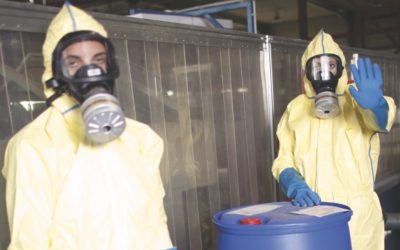
Introduction
The “Protecting and Securing Chemical Facilities from Terrorist Attacks Act of 2004,” authorized the U.S. Department of Homeland Security (DHS) to develop Chemical Facility Anti-Terrorism Standards (CFATS). The DHS CFATS regulations were issued as a final rule in November 2007. The CFATS program focuses on preventing chemicals of interest from being stolen, diverted, sabotaged or deliberately released by terrorists or other bad actors.
Under CFATS, chemical facilities possessing more than a threshold amount of specific explosive, toxic, or other “chemicals of interest” determined by DHS, are required to complete a “top-screen,” notifying DHS that they possess such chemicals on site. Once a facility submits its top-screen, DHS can direct the facility to submit a Security Vulnerability Assessment (SVA). The SVA provides the basis for DHS to assign the facility to one of four tiers: Tiers 1 and 2 being the highest risk, and Tiers 3 and 4 being the lowest. Tier assignment triggers a requirement to submit a Site Security Plan (SSP) or an Alternative Security Plan (ASP) to DHS for authorization and approval.
Read More…
CFATS currently covers more than 3,200 chemical facilities, which have been assessed to present a risk of terrorist attack or exploitation.
DHS implements the CFATS program under a variety of short-term authorizations by Congress. Authorization for the current CFATS standards will sunset after July 27, 2023, if Congress does not reauthorize the program. Congress has historically considered a multi-year reauthorization for the CFATS program, but at this writing, reauthorization legislation has yet to be introduced.
The American Coatings Association (ACA), which represents the more than $26 billion paint and coatings manufacturing industry in the United States, operating in all 50 states, and employing over 50,000 people engaged in the manufacture and distribution of its products, strongly encourages multi-year reauthorization of the CFATS program. Many paint and coating facilities have previously submitted top-screens to DHS identifying chemicals of interest and have been assigned preliminary or final tiers by the department. As a result, many ACA member companies have been subject to the CFATS Risk-Based Performance Standards for some time.
ACA supports the safe handling and use of chemicals, and the structure which CFATS provides to enable that in practice. ACA is also a longstanding member of the Chemical Sector Coordinating Council (CSCC). Organized by DHS, the CSCC expands communication between industry and DHS. Through the CSCC, ACA has advised DHS on how it might develop more effective solutions to implement and improve chemical security. These recommendations are compiled from ACA’s member companies, who own and operate paint, coatings, resin, or chemical manufacturing facilities and are subject to CFATS, with a clear majority being classified as Tier 4 facilities, while just a few are Tier 3.
This Issue Backgrounder articulates ACA’s support for long-term reauthorization of CFATS as well as recommendations to enable the CFATS program to provide enhanced chemical security for stakeholders, in accordance with the statute’s Congressional intent. These enhancements include regular review of the “chemicals of interest” list and improved coordination for CFATS with other federal chemical security and safety regulatory programs.
Regular Review of the ‘Chemicals of Interest’ List
Appendix A of the CFATS regulation (6 CFR Part 27) lists more than 300 chemicals of interest (COI), and their respective screening threshold quantities categorized under three main security issues:
- Release: Toxic, flammable, or explosive chemicals or materials that can be released at a facility.
- Theft or Diversion: Chemicals or materials that, if stolen or diverted, can be converted into weapons using simple chemistry, equipment, or techniques.
- Sabotage: Chemicals or materials that can be mixed with readily available materials.
Read More…
While the overall aim of this list and screening thresholds are clear, in practice, DHS’s failure to update the COI since the program’s promulgation in 2007 may have unnecessarily expanded the reach of the program. For instance, the current list contains aluminum powder as a COI at a threshold of 100 pounds. DHS subsequently expanded the definition of aluminum powder to include aluminum paste through an interpretation promulgated via the FAQ list maintained by the agency, even though aluminum paste presents a lower risk profile than aluminum powder. ACA and other industry partners engaged in extensive discussions with DHS as to the reasonableness of addressing aluminum paste and powder at the same risk level; however, no action has been taken to alleviate this issue.
In addition, desensitized nitrocellulose continues to be interpreted as nitrocellulose proper, even though its desensitized nature has rendered it non-hazardous via dilution and dampening. ACA supports a review and reevaluation of this chemical to prevent unnecessary burdens on chemical facilities.
ACA urges and supports a comprehensive review and re-evaluation of the COI list so it better reflects only hazardous chemicals that could be a terrorism threat in the wrong hands. ACA maintains that re-evaluation of the COI list will afford industry an opportunity to address issues like this through a formal rulemaking process and urges DHS to regularly review its COI list to make chemical determinations based on risk. Doing so will relieve companies of the burden of unnecessary compliance obligations for low-risk chemicals.


Duplicate Regulatory Requirements
The coatings industry, along with other chemical manufacturing industries, is subject to various regulatory programs that address chemical safety. Beyond CFATS, facilities are subject to the U.S. Environmental Protection Agency’s Risk Management Plan program authorized by Sec. 112(r) of the Clean Air Act; the Occupational Safety and Health Administration’s Process Safety Management; and the Department of Transportation’s Hazardous Materials Regulations. Together these regulations offer a broad “safety net” for chemical use and security when properly implemented. While these programs cover many of the same chemicals, they often apply at different thresholds and have somewhat different objectives based on the agency administering them. For example, CFATS has as its primary objective the development of security measures to prevent the deliberate release of highly toxic chemicals, such as chlorine, or the theft or diversion of other chemicals, such as ammonium nitrate, that can be used to manufacture explosives for use by terrorists.
Read More…
But there are some duplicative requirements. For example, like CFATS, DOT’s Pipeline and Hazardous Materials Safety Administration regulation, HM-232F, requires certain facilities have a security plan; 49 CFR 172 Subpart I requires shippers and carriers of certain hazardous materials to implement security plans; and 49 CFR §172.704(a)(5) requires in-depth security training for each employee of applicable facilities. While there is some obvious overlap on personnel training and security, there is further redundancy with requirements such as OSHA 29 CFR 1910.38, for Emergency Action Plans.
ACA has long supported federal efforts to bolster chemical security; however, CFATS and the associated imposition of overlapping — but differently applied — regulatory requirements does not further the jointly held goal of chemical security. Instead, it imposes additional and unnecessary regulatory requirements and compliance burdens on industry. ACA believes there is a real opportunity for federal agencies to work together to streamline these requirements and provide industry some relief from duplicative, onerous regulatory burdens.
A Ready Partner
ACA considers CFATS a necessary regulatory scheme to help industry and communities be safer and more secure, and as such, urges Congress to pass long-term reauthorization of the CFATS program. ACA is eager to work with Congress and DHS as it considers ACA’s recommendations, which would give industry regulatory certainty and stability to make prudent risk management decisions and investments.
CONTACT
For more information, contact:
Heidi McAuliffe
Vice President, ACA Government Affairs
hmcauliffe@paint.org
Rhett Cash
Counsel, ACA Government Affairs
rcash@paint.org
